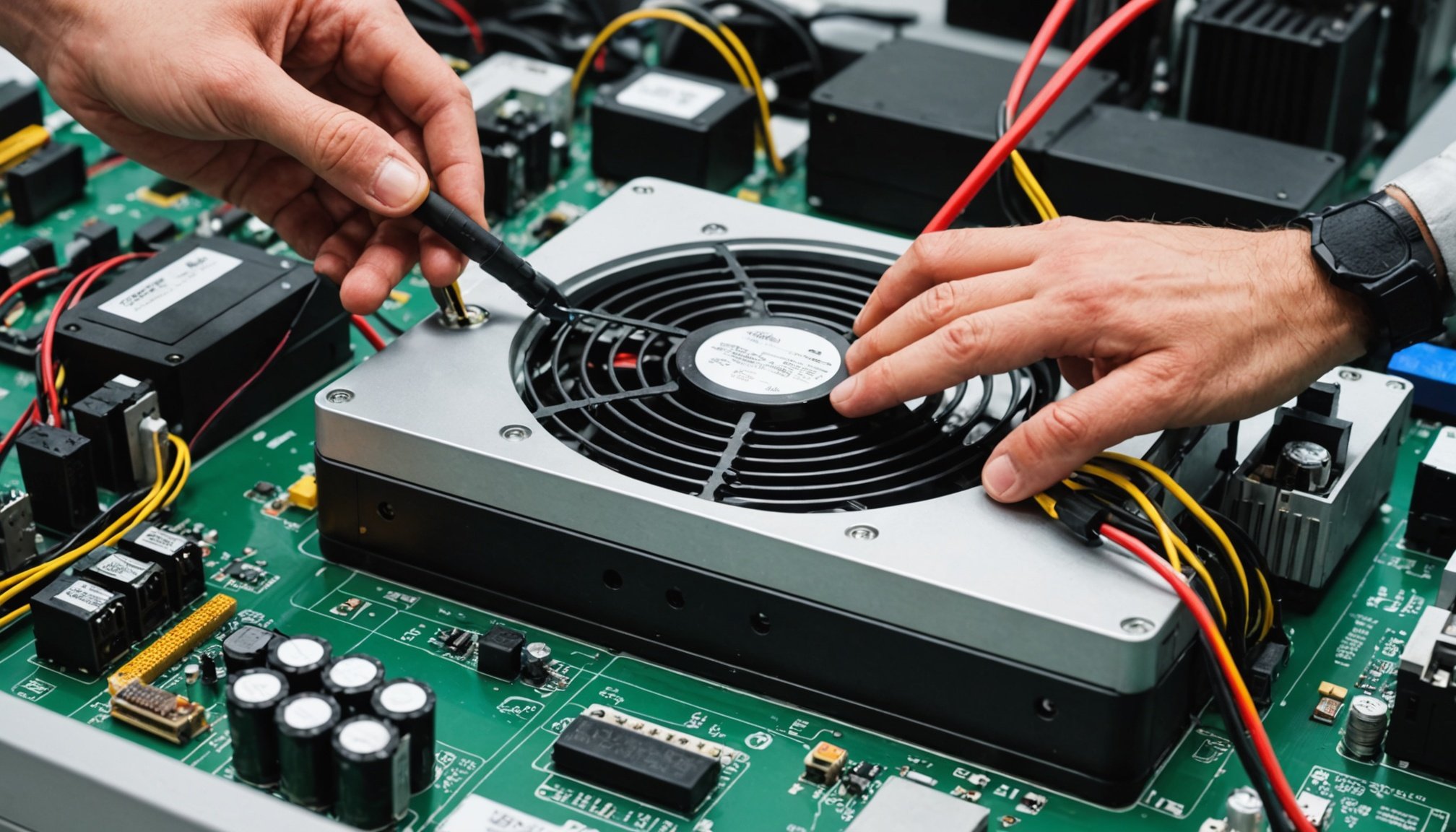Understanding Power Supply Units (PSUs)
A power supply unit (PSU) plays a crucial role in a computer by converting electrical power from a source into usable energy for the system components. It ensures that the right amount of power is delivered steadily and safely to the computer’s hardware. This continuous flow of power is vital for system performance, impacting how components like the CPU and GPU operate.
Key Components of a PSU
A PSU typically consists of several essential components:
Additional reading : Maximizing your pc’s potential: a guide to effective performance benchmarking tools
- A transformer adjusts the incoming voltage to suitable levels.
- Rectifiers and filters work together to convert alternating current (AC) to direct current (DC).
- Voltage regulators maintain a constant output voltage despite any variations in load or input voltage.
Together, these components ensure that energy is distributed effectively across the system. The reliability of these parts is fundamental for the performance and stability of your system. A high-quality PSU can prevent issues such as random shutdowns or the system not booting at all, protecting your investment in high-performance components.
In sum, the PSU acts as the backbone of your computer’s power management, safeguarding both efficiency and longevity.
Also to read : Exploring the advantages of modular power supplies for your custom pc build
Understanding Power Supply Units (PSUs)
A Power Supply Unit (PSU) is a crucial component in computers, responsible for converting electrical energy from an AC source to the low-voltage DC power that different computer components require. Without the PSU, a computer would be unable to function, as it powers every component, from the CPU to peripheral devices.
PSU Functionality
PSUs not only provide power but also regulate voltage to ensure stable operation. Each PSU has a specific wattage rating, indicating its power capacity. Ensuring your PSU can handle the power demands of your components prevents potential damage and ensures efficient performance.
PSU Components
Key components include:
- Transformer: Converts the incoming voltage to a different level.
- Rectifier: Converts AC to DC.
- Regulator: Stabilises the voltage output.
- Cooling Fan: Prevents overheating by dissipating heat.
The importance of a PSU in system performance and stability cannot be overstated. A reliable PSU supports the longevity of your system by ensuring consistent power delivery and protection from electrical inconsistencies. Selecting a high-quality PSU tailored to your needs will ultimately enhance your computer’s performance, making knowledge about PSUs critical for any system builder.
Evaluating Power Supply Requirements
Understanding the power needs of your system is crucial for choosing the right power supply unit (PSU). Your computer’s performance depends on having sufficient and steady power, and calculating the wattage requirements is an essential step. To determine these needs, consider each component’s power consumption, such as your CPU, GPU, and storage drives. Adding these values provides a baseline, ensuring your PSU can handle the combined load comfortably.
Tools and formulas are available to simplify this process. Online calculators can provide an estimate by allowing you to input your specific components. This helps in gauging whether your PSU’s wattage can meet the demand during peak usage scenarios.
When it comes to hardware compatibility, it’s vital to ensure the PSU has the correct connectors and power ratings for each component. Compatibility with your CPU and GPU is a major consideration; not all PSUs support every type of hardware. Additionally, consider the PSU’s form factor and whether it will physically fit into your computer case. A well-matched PSU enhances overall system stability and helps avoid future compatibility issues.
Evaluating Power Supply Requirements
Understanding your computer’s power needs is essential for optimal performance and reliability. Calculating the correct wattage for your system prevents overloading your PSU and ensures longevity for your components.
Determining Total Wattage
To determine total wattage needs, assess each hardware component’s power consumption. Components such as the CPU and GPU typically demand the most power. You can use online power calculators that consider these power requirements, offering a practical estimate. These tools recommend a PSU based on your components, considering built-in safety margins. A clear understanding of wattage calculation helps prevent underestimating power needs, which could lead to hardware failures.
Assessing Hardware Compatibility
To ensure your PSU meets hardware compatibility, evaluate its connectors and modularity. The PSU should include sufficient connectors for devices like SSDs, HDDs, and graphics cards. Modularity allows you to use only the cables you need, promoting efficient cable management and airflow. Additionally, check the PSU’s form factor; it must fit within your computer case without obstructing other components. Always prioritize compatibility with your CPU and GPU to avoid performance bottlenecks and ensure seamless operation.
PSU Efficiency Ratings
Grasping PSU efficiency ratings is key to understanding your power supply’s performance. Efficiency measures how well the PSU converts power from AC to DC without unnecessary energy loss. Higher efficiency results in less excess heat, leading to reduced energy bills and improved system longevity. Efficiency ratings assess this performance, often represented in percentages.
The most recognized standard for efficiency is the 80 Plus certification, which categorizes PSUs based on their performance level. This certification includes levels such as Bronze, Silver, Gold, Platinum, and Titanium. Each ascending level signifies increasing efficiency and energy savings. For example, an 80 Plus Bronze PSU offers around 82-85% efficiency, while Titanium units can exceed 94%.
Higher efficiency PSUs not only save money on electricity but also offer enhanced reliability and quieter operation by producing less heat. When selecting a PSU, consider these ratings to choose a power supply that matches your performance and environmental goals. Selecting a high-efficiency unit can result in long-term cost savings and less heat-related wear on your system, making it a practical long-term investment.
PSU Efficiency Ratings
When selecting a power supply unit, understanding its efficiency rating is crucial in ensuring optimal performance and energy savings. Efficiency ratings indicate how efficiently a PSU converts AC power to DC power for your components, with less wasted energy as heat.
The 80 Plus Standard
The 80 Plus Standard is a popular certification indicating a PSU’s efficiency under specific load conditions. This certification includes several levels, such as Bronze, Silver, Gold, Platinum, and Titanium. The basis of these ratings lies in the PSU maintaining at least 80% efficiency at 20%, 50%, and 100% loads.
The Importance of High Efficiency
PSUs with higher efficiency ratings provide indirect cost savings by reducing electricity bills and improving the performance of your system. Higher efficiency units generate less heat, thereby minimizing the need for extensive cooling solutions. This reliability enhances system longevity by preventing power fluctuations and overheating.
Choosing the Right Efficiency
To match your demands, balance between initial PSU cost and long-term savings. Consider your computer usage patterns and potential upgrades. For gaming or professional setups, opting for a Gold or higher-rated PSU can improve stability and efficiency, warranting the investment.
Troubleshooting Power Supply Issues
When encountering computer performance issues, your power supply unit (PSU) can often be the root cause. Recognizing the signs of a failing PSU is crucial to avoid significant hardware damage. Look for symptoms such as frequent system crashes, unexpected shutdowns, or components not receiving power. These issues often indicate that your PSU is unable to deliver consistent power to your system.
Basic Troubleshooting Steps
To diagnose PSU problems, begin with simple checks. First, ensure all power cables are securely connected to both the PSU and system components. Inspect these cables for any visible damage, as compromised cables can lead to power inconsistencies. Next, test the system by swapping out the current PSU with a known working unit to see if the problem persists.
Safety precautions are paramount when working with PSUs. Before performing any troubleshooting, unplug the power source to prevent electric shock. Never open the PSU casing, as this can be extremely dangerous.
While troubleshooting, keep in mind that common problems, such as a noisy fan or overheating, could indicate an impending PSU failure. A replacement might be necessary if these issues cannot be resolved through basic troubleshooting steps. Understanding these critical factors can significantly contribute to maintaining system stability and longevity.
Recommendations for Choosing the Right PSU
Choosing the correct Power Supply Unit (PSU) is critical to ensuring that your computer’s components receive stable and efficient power. When evaluating options, it’s important to consider quality brands known for reliability and performance. Leading PSU manufacturers such as Corsair, Seasonic, and EVGA have established reputations, often noted for their durability and broad selection suitable for various needs and budgets.
Top PSU Brands and Models
- Corsair is renowned for delivering dependable power supplies across diverse categories, from basic models to high-capacity units suited for gaming and professional use.
- Seasonic is often a go-to brand for those seeking long-term warranties and high-efficiency ratings, appealing to users keen on energy savings and quiet operation.
- EVGA is popular among gamers, offering a range of PSUs with robust warranty support and innovative design features.
When selecting a PSU, consider models that align with your power needs, offering necessary wattage alongside efficient performance. Pay attention to features like modular cables, which aid in maintaining tidy builds and promoting good airflow. Evaluating several models against your specific requirements helps ensure a seamless match with your system, enhancing both longevity and functionality.
Recommendations for Choosing the Right PSU
When selecting a power supply unit (PSU) for your computer, understanding your system’s needs is paramount. Opting for high-quality brands ensures reliability and longevity. Below are some of the top PSU brands known for their performance and customer satisfaction:
Top PSU Brands and Models
Corsair, EVGA, and Seasonic are widely acclaimed for producing reliable and efficient PSUs. These brands offer a range of models suited for various needs, ensuring that any user, whether a gamer or a professional, can find a fitting power solution. Consider models with at least 80 Plus Gold efficiency ratings, as they balance cost with performance and energy savings effectively.
- Corsair RM Series: Excellent for high-performance systems, offering modular cables for better manageability.
- EVGA SuperNOVA Series: Known for reliability and long warranties, suitable for overclockers.
- Seasonic Focus Series: Praised for compact design and silent operation, perfect for small form builds.
Consumer Feedback and Reviews
Researching consumer reviews can provide insights into real-world performance and potential issues. Look for feedback on noise levels, cable length, and ease of installation. Remember, thorough research helps in avoiding common pitfalls, such as incompatibility or inadequate power delivery, ensuring a seamless experience with your chosen PSU.
Troubleshooting Power Supply Issues
Experiencing power-related problems with your computer often points to power supply unit (PSU) issues. Recognizing these symptoms—such as random restarts, system crashes, or inactive components—is essential to averting hardware damage. If you’re facing these issues, your PSU should be a primary suspect.
Basic Troubleshooting Steps
To start, ensure all PSU and component power cables are securely connected. Loose connections can lead to inconsistent power delivery, impacting system stability. Check for any visible cable damage that might contribute to power failures. Moreover, you can attempt to swap the PSU with a functioning unit to verify if the power supply is at fault.
Solutions for Common Problems
Noise from the PSU fan may indicate dust accumulation or bearing issues, requiring cleaning or replacement. Overheating signifies potential inefficiencies or inadequate ventilation, an indication that additional cooling or a higher-rated PSU might be necessary.
Safety Precautions
Always prioritize safety by disconnecting all power before troubleshooting. Never open a PSU casing, as this poses a risk of electrical shock. If persistent issues occur beyond basic checks, professional servicing or replacement is advisable to maintain system stability.


